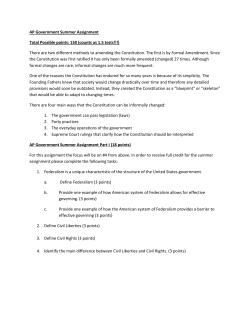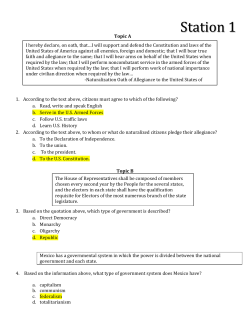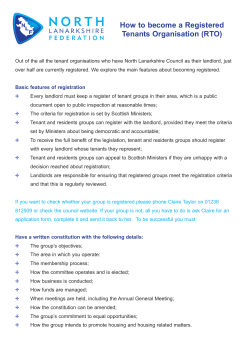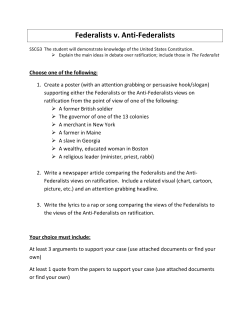
I. What is a Constitution? II. The Preamble States the Goals of the C
The United States Constitution: Skeleton Notes and “Whole-‐Brain” Connectors I. What is a Constitution? A ____________________________ is a written document that sets out the laws and principles of a government. A constitution lists the powers a government has as well as the limitations it has on the people of the country it governs. The Preamble: “We the people of the United States, in order to form a more perfect Union, establish justice, ensure domestic tranquillity, provide for the common defense, promote the general welfare, and secure the blessings of liberty to ourselves and our posterity, do ordain and establish this Constitution for the United States of America.” II. The Preamble States the Goals of the Constitution: Goal #1: “Form a More Perfect Union” The Constitution was designed to get the states to work together as a part of a single, united nation. Under the previous government, _________________ _____________________________, states ran themselves like independent nations; each with its own rules, laws, and courts and often with little regard for the well-‐ being of the other states. To achieve this the Constitution gave broad powers exclusively to the national government (a national legislature called __________________). In addition, a national executive (the __________________) was created to carry out the laws, and federal courts were established to see that laws are carried out consistently throughout the country. Name: __________________________________________ Period: ___________ Whole-‐Brain Connectors Goal #2: “Establish Justice” This goal states that ___________________which means all laws must be fairly applied to every American citizen regardless of race, religion, gender, country of origin, political beliefs, or financial situation. To ensure this takes place the Constitution created a system of federal ___________________ to settle disputes between individuals, between individuals and the national government, national laws, foreign treaties, foreign ambassadors, national laws, disputes between states, and the interpretation of the Constitution itself. Goal #3: “Ensure Domestic Tranquillity” The Constitution gave the national government the power to ensure “__________________________________” or in other words, ____________ at ___________. The government has allowed local and state governments to enforce national laws within their borders. When crimes cross state lines national police agencies (like the FBI) step in to investigate and help protect life and property. The Constitution also allows for the President to summon the National Guard to keep the peace when local governments cannot. Goal #4: “Provide for the Common Defense” The Constitution gives Congress the power to “raise and support Armies” and to “provide and maintain a navy”. Today this includes all five branches of the armed forces: army, navy, air force, marines, and the coast guard. The Constitution establishes the principle that the military is under __________________ control, NOT the ______________ itself. The President serves as __________________________ in ________________ of the armed forces. Goal #5: “Promote the General Welfare” _________________ ________________________ means the Constitution gives the national government the power to take care of the well-‐being of its people. The government has the power to collect taxes and use the funds to create programs and services that benefit the people. Examples: safety standards for workers, unemployment insurance, social security benefits, supporting education, school lunches and nutrition programs, student loans and grants, research projects, and government agencies that protect the safety of citizens. Goal #6: “Secure the Blessings of Liberty” _________________ is the freedom to live as you please, as long as you obey the laws and respect the rights of others. The Constitution was written to ____________ the powers of government. Examples include the ___________ of ________________which states rights the government cannot take away. The Constitution provides citizens with a safeguard—the right to _____________. The people select their leaders and also have the power to remove them. The Constitution has also been changed to extend ___________________ to more and more people over time. III. Five Principles of the Constitution A. The framers of the Constitution recognized the need for a strong national government but they were very concerned that all the power not fall completely in the hands of a small, elite, privileged group. To achieve this, the framers rested the Constitution on five basic principles. Principle #1: Popular Sovereignty The first three words of the Constitution read “We the people”. According to the principle of ___________ ___________________________, the people hold the final authority in government. In a large society like the U.S. not all people can directly participate in their government but they may indirectly participate by electing people to represent them. This system is known as ___________________ _____________________________. Principle #2: Limited Government The principle of _______________ _______________________ is based on the idea that the government has only the powers given to it by the people. The Constitution specifically tells the government the powers it has and also states the powers it does not have. The most important example of limited government is the Bill of Rights which guarantees the national government may not take away individual freedoms of the people. Principle #3: Federalism The principle of _____________________ divides power between the federal government and state governments. The federal government has the power to deal with ______________________ issues while states have the power to deal with _________________ or regional issues. Both the states and national governments have some powers exclusively given to them while some powers are shared. Powers of States: Powers of states are not listed specifically in the constitution instead states are given all powers not specifically given to the national government. (10th Amendment) In addition, all states are given representation in the national government. Federalism is intended to be a working partnership between the federal and state governments. However, disputes sometimes arise. Disputes between state and national governments are settled in federal courts or the Supreme Court if needed. The Constitution is however the “law of the land”. Principle #4: Separation of Powers The framers of the Constitution wanted to prevent abuse by any one person or group. To ensure abuse would not occur the Constitution divides the national government into three branches with each branch having its own powers and responsibilities. 1. ______________________________: known as Congress, the legislative branch is made up of the House of Representatives and the Senate. Powers of this branch include the ability to tax, to coin money, and declare war. 2. ______________________________: purpose of this branch is to carry out the laws passed by Congress. The head of this branch is the President. 3. _______________________________: purpose of this branch is to interpret and explain laws. This branch also determines if laws are constitutional. The head of this branch is the Supreme Court. Principle #5: Checks and Balances To ensure that no one branch of government became to powerful the framers set up a system of “checks and balances” that allows one branch the ability to limit or “check” the power of the other. These checks are: 1. Checks on Congress (Legislative Branch) Congress’s main job is to pass _____________, also known as laws. Checks on this branch include: § President (executive branch) can ____________, or reject a bill he does not support. § The Supreme Court (judicial branch) has the power to declare a bill ________________________, or not permitted by the Constitution. A law that is declared unconstitutional cannot become a law. 2. Checks on the President (Executive Branch) Checks on this branch include: § Only _______________ (Legislative Branch) has the power to declare __________, even though the President is commander-‐in-‐chief. § The president can make treaties but they must be approved by the ___________________ (Legislative Branch) § Congress may override a Presidential veto with _________ vote (Legislative Branch) § The Supreme Court can declare an act of the President as ___________________________ (Judicial Branch) 3. Checks on the Courts (Judicial Branch) Checks on this branch include: • The President ________________ all federal judges (Executive Branch) and Congress approves them (Legislative Branch). • Congress has the power to _____________ unjust federal judges. (Legislative Branch) • Congress may propose constitutional _______________________ to overrule a judicial decision (Legislative Branch). IV. A Living Document The framers of the Constitution were well aware of the need to create a document that could be changed as the country grew and the needs of the nation changed. To ensure this happened a “____________ _________________________” was created that could change with the times. A. Making Changes to the Constitution: The framers the Constitution created a method for changing the Constitution. Changes to the Constitution are called _______________________. Amendments are formal ___________________ changes to the Constitution. The amendment process is a difficult process to ensure that only the most important changes are ever made to the document. Amending the Constitution requires two steps (1) _____________________, and (2) __________________________. 1. Proposing an Amendment There are 2 ways in which an amendment may be _______________________: 1. ________ of each _________________ of __________________ can vote to propose an amendment 2. ________ of each ____________ _______________________ can demand Congress call a national “convention” to propose an amendment (this has never been used so far) 2. Ratifying an Amendment There are 2 ways in which an amendment may be ______________________ (approved): 1. _________ of the state __________________ nationwide must approve the amendments 2. ________ of each state meeting in special _______________________ must approve the amendments. V. The 27 Amendments A. The first ______ amendments were added between 1787 and 1791. These amendments list and protect the basic rights of people. These first ten amendments are known as ____________________________________________________________. The Bill of Rights Amendment 1: freedom of ___________________, ____________________, _________________________, and ______________________ Amendment 2: Right to Bear ____________ Amendment 3: No quartering of ______________________ Amendment 4: _______________ and _____________________ Amendment 5: Rights of the ________________________ Amendment 6: Right to Speedy ______________ by __________ Amendment 7: Jury Trial in ____________ Cases Amendment 8: No excessive ___________ or cruel or unusual ______________________ Amendment 9: __________________ Reserved to the ________________ – other rights not mentioned in the Constitution may exist; these belong to the people. Amendment 10: _________________ Reserved to the _______________________ (powers not listed specifically to the federal government belong to the states) Other Key Amendments Amendments 13-‐15: “Civil War” amendments – passed to protect the rights of former slaves. 13th Amendment: abolished ____________________ 14th Amendment: guaranteed ____________________ and constitutional _____________ to African Americans 15th Amendment: guaranteed African American men the right to ___________ Amendments 19 and 26: “Equality” amendments – passed to protect the rights of other groups 19th Amendment: gave _____________ the right to _________ 26th Amendment: set the national voting age at ________ years of age. VI. Good Citizenship – Rights, Responsibilities, and Civic Values A. Citizen’s Rights 1. The _______ of _______________ protected basic rights, but states were still able to deny basic rights to certain groups because the Bill of Rights initially was for white, property-‐holding ___________. The __________ amendment helped solve this issue. 2. The 14th amendment states that citizens born in the U.S. are citizens of both the _____________ and their _______________ and may not be denied rights under the U.S. Constitution and the Bill of Rights. Citizens are entitled to __________ _______________ under the law and must be treated equal regardless of _______________________. 3. The _______ amendment states that people have rights beyond those listed in the Constitution. Confusion exists over what is a “right” and what is not. Examples: Is health care a right? Is a good education a right? B. Citizens’ Responsibilities 1. Know your _____________ and the ______________ of your rights. 2. Become involved – ________ using informed decisions, keep informed of national and community _______________, attend government meetings, serving on a _______________ when summoned. 3. Obey all ___________ and accept consequences for breaking them. C. Civic Values 1. Respect the ______________ of others. 2. ______________________ to help your neighbors and community. 3. Sign up for ______________________ Service in case of a national emergency.
© Copyright 2025









